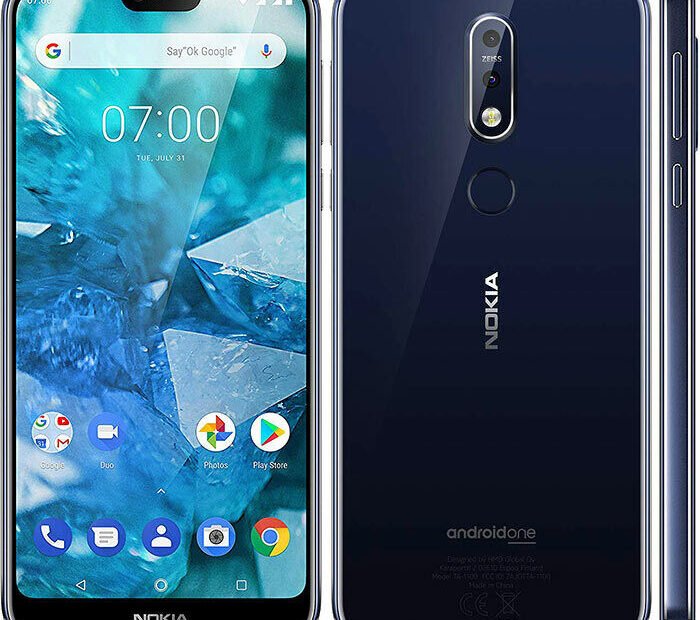Introduction
The Nokia 7.1, released in October 2018, was positioned as a mid-range smartphone offering a blend of premium design, solid performance, and a clean Android experience. As part of HMD Global’s revival of the Nokia brand, the 7.1 aimed to deliver a stock Android experience with timely updates, making it a strong competitor in its price segment. This review will cover its hardware, software, performance, and how it stacks up against rivals.
Hardware Specifications
Design & Build
- Dimensions: 149.7 x 71.2 x 8 mm
- Weight: 160g
- Build: Glass front (Gorilla Glass 3), glass back, aluminum frame
- Colors: Gloss Midnight Blue, Gloss Steel
- Water Resistance: No official IP rating
The Nokia 7.1 features a sleek glass-and-metal design, giving it a premium look despite its mid-range positioning. The phone feels sturdy, though the glass back is prone to fingerprints and minor scratches.
Display
- Type: IPS LCD, HDR10 support
- Size: 5.84 inches
- Resolution: 1080 x 2280 pixels (~432 PPI)
- Aspect Ratio: 19:9
- Notch: Yes (small top-notch)
The HDR10-compliant display is one of the highlights, offering vibrant colors and good brightness levels. The Full HD+ resolution ensures sharp visuals, though OLED competitors may offer deeper blacks.
Performance
- Chipset: Qualcomm Snapdragon 636
- CPU: Octa-core (4×1.8 GHz Kryo 260 Gold & 4×1.6 GHz Kryo 260 Silver)
- GPU: Adreno 509
- RAM: 3GB / 4GB variants
- Storage: 32GB / 64GB, expandable via microSD (up to 400GB)
The Snapdragon 636 provides decent performance for everyday tasks but struggles with heavy gaming. The 4GB RAM variant is preferable for smoother multitasking.
Camera
- Rear Cameras:
- 12 MP (f/1.8, 1.28µm, PDAF, Zeiss optics)
- 5 MP depth sensor (f/2.4)
- Features: Dual-LED dual-tone flash, HDR, panorama
- Video Recording: 4K@30fps, 1080p@30fps
- Front Camera: 8 MP (f/2.0, 1.12µm), 1080p@30fps
The Zeiss-branded cameras produce good daylight shots with accurate colors, but low-light performance is average. The depth sensor helps with portrait mode, though edge detection isn’t perfect.
Battery & Charging
- Battery Capacity: 3060 mAh
- Charging: 18W fast charging (Quick Charge 3.0)
- Battery Life: Moderate (lasts a full day with light usage)
The battery is a weak point, as competitors offered larger capacities. Fast charging helps, but heavy users may need a midday top-up.
Connectivity & Ports
- USB: USB Type-C 2.0
- 3.5mm Jack: Yes
- Bluetooth: 5.0
- Wi-Fi: 802.11 a/b/g/n/ac
- NFC: Yes
- FM Radio: Yes
Audio
- Single speaker (decent output)
- No stereo speakers
Security
- Rear-mounted fingerprint sensor (fast and reliable)
- Face unlock (software-based, less secure)
Software Specifications
- OS at Launch: Android 8.1 Oreo (upgradable to Android 10)
- UI: Stock Android (Android One program)
- Update Policy: Guaranteed monthly security updates for 3 years
The clean Android experience is a major selling point, with no bloatware and timely updates. However, the phone is no longer supported with major OS upgrades.
Comparison with Competitors
| Feature | Nokia 7.1 | Xiaomi Redmi Note 7 | Motorola Moto G7 | Samsung Galaxy A50 (2019) |
|---|---|---|---|---|
| Display | 5.84″ IPS LCD, HDR10 | 6.3″ IPS LCD | 6.2″ IPS LCD | 6.4″ Super AMOLED |
| Processor | Snapdragon 636 | Snapdragon 660 | Snapdragon 632 | Exynos 9610 |
| RAM/Storage | 3/4GB + 32/64GB | 3/4GB + 32/64GB | 4GB + 64GB | 4/6GB + 64/128GB |
| Rear Camera | 12MP + 5MP (Zeiss) | 48MP + 5MP | 12MP + 5MP | 25MP + 8MP + 5MP |
| Battery | 3060 mAh (18W charging) | 4000 mAh (18W charging) | 3000 mAh (15W) | 4000 mAh (15W) |
| Software | Android One (Stock) | MIUI (Custom) | Near-stock Android | One UI (Custom) |
| Price (2019) | ~$350 | ~$200 | ~$300 | ~$350 |
Key Takeaways:
- The Nokia 7.1 stood out for its premium build and stock Android experience but lagged in battery life and raw performance.
- The Redmi Note 7 offered better specs (SD 660, 48MP camera, larger battery) at a lower price but had MIUI bloatware.
- The Moto G7 was a close competitor with near-stock Android but weaker specs.
- The Galaxy A50 had a superior AMOLED display and better chipset but a higher price.
Pros & Cons
Pros:
- Premium glass-and-metal design
- Clean Android One experience with timely updates
- HDR10 display for better multimedia consumption
- Decent camera performance in daylight
- Expandable storage
Cons:
- Below-average battery life
- Snapdragon 636 struggles with heavy tasks
- No water resistance
- Low-light camera performance is mediocre
Final Verdict
The Nokia 7.1 was a well-rounded mid-ranger with a strong emphasis on design and software. While it couldn’t match rivals in raw power or battery life, its stock Android experience and build quality made it a compelling choice for users prioritizing a clean interface and reliability. Today, it remains a decent secondary device but is outclassed by modern budget phones.
